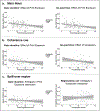Recovery from misinterpretations during online sentence processing
- PMID: 33252925
- PMCID: PMC9535118
- DOI: 10.1037/xlm0000936
Recovery from misinterpretations during online sentence processing
Abstract
Misinterpretations during language comprehension are common. The ability to recover from processing difficulties is therefore crucial for successful day-to-day communication. Previous research on the recovery from misinterpretations has focused on sentences containing syntactic ambiguities. The present study instead investigated the outcome of comprehension processes and online reading behavior when misinterpretations occurred due to lexical-semantic ambiguity. Ninety-six adult participants read "garden-path" sentences in which an ambiguous word was disambiguated toward an unexpected meaning (e.g., "The ball was crowded"), while their eye movements were monitored. A meaning coherence judgment task required them to decide whether or not each sentence made sense. Results suggested that readers did not always engage in reinterpretation processes but instead followed a "good enough" processing strategy. Successful detection of a violation of sentence coherence and associated reinterpretation processes also required additional processing time compared to sentences that did not induce a misinterpretation. Although these reinterpretation-related processing costs were relatively stable across individuals, there was some evidence to suggest that readers with greater lexical expertise benefited from greater sensitivity to the disambiguating information, and were able to flexibly adapt their online reading behavior to recover from misinterpretations more efficiently. (PsycInfo Database Record (c) 2021 APA, all rights reserved).
Figures



References
-
- Adlof SM, Catts HW, & Little TD (2006). Should the Simple View of Reading Include a Fluency Component? Reading and Writing, 19(9), 933–958. 10.1007/s11145-006-9024-z - DOI
-
- Baayen RH, Davidson DJ, & Bates DM (2008). Mixed-effects modeling with crossed random effects for subjects and items. Journal of Memory and Language, 59(4), 390–412. 10.1016/j.jml.2007.12.005 - DOI

